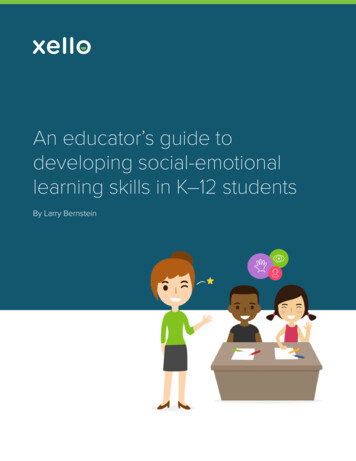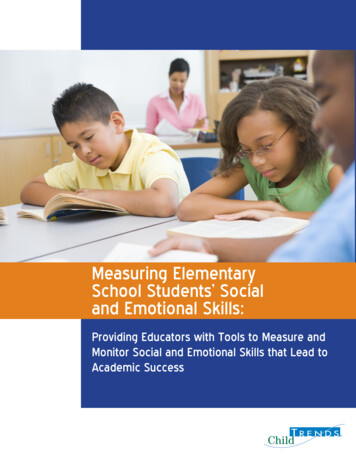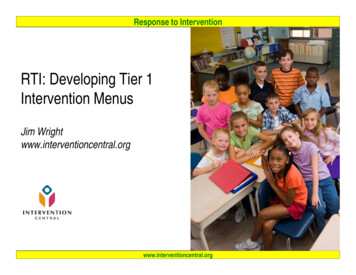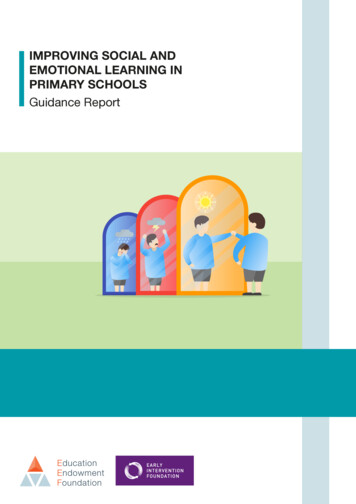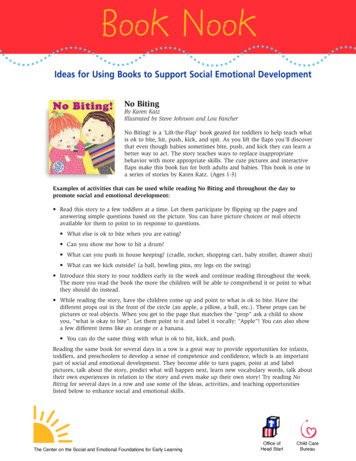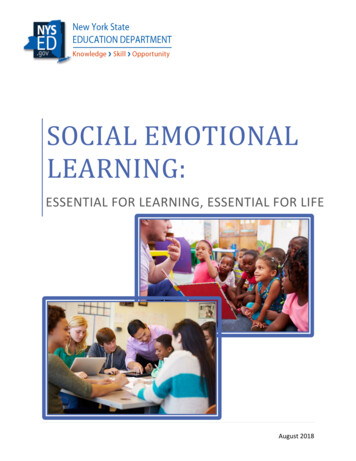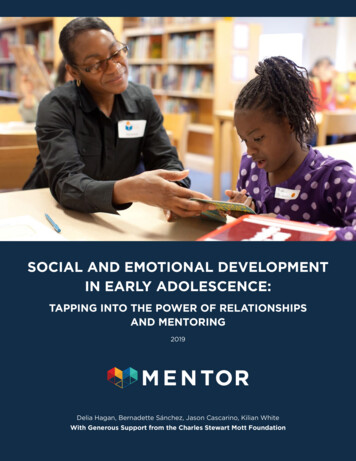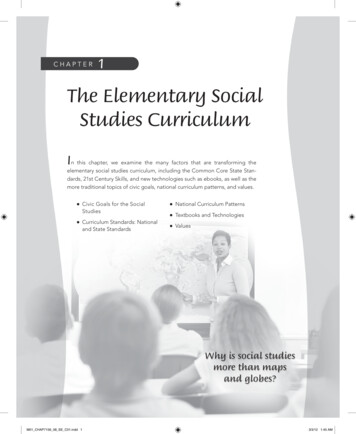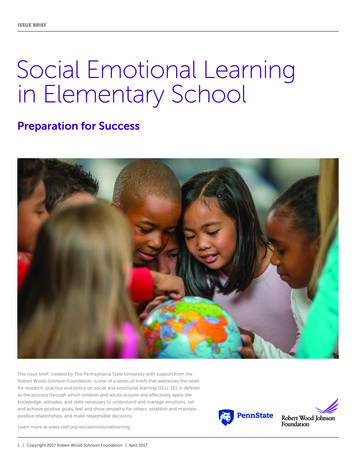
Transcription
issue briefSocial Emotional Learningin Elementary SchoolPreparation for SuccessThis issue brief, created by The Pennsylvania State University with support from theRobert Wood Johnson Foundation, is one of a series of briefs that addresses the needfor research, practice and policy on social and emotional learning (SEL). SEL is definedas the process through which children and adults acquire and effectively apply theknowledge, attitudes, and skills necessary to understand and manage emotions, setand achieve positive goals, feel and show empathy for others, establish and maintainpositive relationships, and make responsible decisions.Learn more at www.rwjf.org/socialemotionallearning.1 Copyright 2017 Robert Wood Johnson Foundation April 2017
issue briefExecutive SummaryAt the elementary-school level, social and emotionallearning (SEL) enhances students’ abilities to understandand manage their emotions, set and achieve personal andacademic goals, show respect and empathy for others,establish and maintain positive relationships, and makeresponsible and ethical decisions.1 These personal andinterpersonal competencies provide a foundation forsuccess in work and relationships as adults.2,3,4 This briefsummarizes several key findings:Movement Toward SEL GoalsEleven states have articulated explicit goalswith developmental benchmarks for studentSEL at the elementary level.WAVT MEMAIDPA1. Extensive research shows that SEL programs canpromote academic achievement and positive socialbehavior, and reduce conduct problems, substanceabuse, and emotional distress. Benefits of SEL in theelementary years have been documented in reviewsby independent research teams,5,6 and through metaanalyses which demonstrate the immediate and longterm positive outcomes of well-designed,well-implemented S EL programming.7,8,92. SEL is critical to student success and shows a positiveeconomic return on investment.3. Effective SEL programs:ll use four general approaches, addressingeverything from individual student instruction tooverall school climate;1ll are evidence-based and reflect an understanding ofthe process of social and emotional developmentin elementary-school children with appropriateprogramming for different grade levels;ll are enhanced by partnering with families;ll are culturally and linguistically sensitive; andll include the implementation of high quality teachertraining and professional development.2 Copyright 2017 Robert Wood Johnson Foundation April 2017ILKSCTOHWVCurrently, CASEL (the Collaborative for Academic, Social,and Emotional Learning) is aware of at least 11 states(CT, ID, IL, KS, MA, ME, OH, PA, VT, WA, and WV) that havearticulated explicit goals with developmental benchmarksfor student SEL at the elementary level, and an increasingnumber of states and districts are moving in this direction.10Research findings and policy developments thereforesupport the following recommendations for elementaryschool leaders and policymakers:1. Adopt evidence-based SEL programs and activities inorder to improve social-emotional and academic success.2. Provide teachers with ongoing professional developmentand coaching to ensure high quality implementation.3. Support and reinforce student SEL school-wide, and infamily and community partnerships.4. Create state, district, and school policies and guidelines tohelp insure that learning goals for SEL are well developedand aligned with elementary education more broadly.
issue briefIntroductionFor children to succeed during elementary school, infurther schooling and in their careers, they need tobe socially, emotionally, and academically competent.Students’ SEL competencies are built through policies,programs, and practices that enhance children’s andadults’ capacities to understand and manage emotions,set and achieve positive goals, feel and show empathy forothers, establish and maintain positive relationships, andmake responsible decisions.11,12The Collaborative for Academic, Social, and EmotionalLearning (CASEL) has identified five inter-related sets ofcognitive, affective, and behavioral competencies thatcomprise social and emotional learning: self-awareness,self-management, social awareness, relationship skills,and responsible decision making (see next page). Thesecompetencies contribute to better adjustment and schoolperformance, including more positive social behaviors,fewer conduct problems, less emotional distress, andimproved grades and test scores.7,8,9 These competenciesare critical to academic success and positive adjustment inschool13 and in adult employment.14,15Based on extensive research, at least 11 states (CT, ID, IL, KS,MA, ME, OH, PA, VT, WA, and WV) have articulated explicitgoals for student SEL at the elementary level in recentyears. Even more states are moving in this direction.10 (seeState Report) Developing policies and guidelines to supportlearning goals for student SEL naturally raises a questionabout whether there are assessment tools availableto monitor student progress. A variety of formal SELassessment tools exist—including teacher ratings, studentself-reports, peer and parent ratings, observations, andperformance tasks. Leading experts recommend that states:a. use direct measures of students’ social and emotionalskills to inform the teaching and learning processrather than for school accountability, andb. consider including student surveys measuring schoolclimate and learning opportunities, along with dataon chronic absenteeism, suspension, and expulsionrates as state-reported indicators under ESSA.163 Copyright 2017 Robert Wood Johnson Foundation April 2017A recent report from the Learning Policy Institute points outthat indicators of students’ social and emotional skills canbe powerful levers of change at the classroom or schoollevel, and that states might support these local measures toguide schools’ continuous improvement efforts.16This brief examines the evidence of successful, universalSEL programs and practices used to support social andemotional development in students during the elementaryyears (K-5). Based on decades of research and evaluationin rigorous field trials, these approaches are now widelyavailable to schools, along with teacher training andongoing coaching to support high quality implementation.Benefits of Social and Emotional LearningocialPositive sbehaviorsductFewer conproblemstionalLess emodistressgradesImproved scoresand test
issue briefThe Five SEL Competency ClustersSelf-awarenessSelf-managementSocial awarenessThe ability to accuratelyrecognize one’s feelings andthoughts and their influenceon behaviors. This includesaccurately assessing one’sstrengths and limitations,and possessing a growthmindset, a well-groundedsense of self-efficacy andoptimism.The ability to regulate one’semotions, cognitions, andbehaviors to set and achievepersonal and educationalgoals. This includes delayinggratification, managingstress, controlling impulses,motivating one’s self, andpersevering in addressingchallenges.The ability to take theperspective of andempathize with others fromdiverse backgrounds andcultures, to understandsocial and ethical normsfor behavior, and torecognize family, school,and community resourcesand supports.Relationship skillsThe ability to establish andmaintain healthy and rewardingrelationships with diverseindividuals and groups. Thisincludes communicating clearly,listening actively, cooperating,resisting inappropriate socialpressure, negotiating conflictconstructively, and seeking helpwhen needed.Responsibledecision-makingThe ability to make constructivechoices about personal behavior,social interactions, and schoolbased on consideration of ethicalstandards, safety concerns, socialnorms, realistic evaluation ofconsequences of various actions,and the well-being of self andothers.Note: The five SEL competency clusters as defined by the Collaborative for Academic, Social and Emotional Learning (CASEL)in the 2013 CASEL Guide: Effective Social and Emotional Learning Programs, Preschool and Elementary School Edition4 Copyright 2017 Robert Wood Johnson Foundation April 2017
issue briefKey FindingsSchool-based programs designed to promote student social andemotional development at the elementary school level are effectiveat promoting academic achievement, reducing conduct problems,improving prosocial behavior, and reducing emotional distress.Over the past 20 years, a compelling and extensive body of research for SELprograms (K-12) has been amassed, including replications and longitudinalfollow-ups. A meta-analysis including 213 rigorous studies and over 270,000students demonstrated that students who received SEL programs performedbetter than students who did not. They showed an 11 percent gain onmeasures of academic achievement, and similar significant improvements inconduct and discipline, prosocial behavior, and/or emotional distress.7 A total of120 of the 213 studies (56%) in the meta-analysis were conducted specificallyat the elementary (k-5) level. Independent research groups have replicatedthese findings. For example, a European team conducted a meta-analysis of 75studies and reported similarly positive findings.8In 2013, CASEL conducted an extensive review of SEL programs designedfor use during the elementary school years and identified 19 evidencebased programs. Eight of these programs have now had replications anddemonstrated significant positive effects for at least two years: Caring SchoolCommunity, PATHS, Positive Action, Resolving Conflicts Creatively Program,Responsive Classroom, Second Step, Social Decision Making/Problem SolvingProgram, and Steps to Respect. Narrative reviews of SEL in elementary schoolsettings identified five of these programs—Caring School Community, PATHS,Positive Action, Responsive Classroom and Second Step—as having at least3 separate studies demonstrating their effectiveness.5,6SEL programs produce positive long-term student benefits andoffer a strong financial return on investment.Teachers view social and emotional competencies as critical for college andcareer success, and support educational approaches designed to promote SELin their students.13 Research has shown that SEL skills are critically importantto success in work, especially for higher paying jobs, and employers stronglyadvocate that education should promote these important “21st century skills.”14,15Recently, a meta-analysis of follow-up studies (6 months to 18 years after theintervention) of 82 SEL interventions (97,000 students; 38% were elementarystudents) found the benefits of SEL programs to be durable over time and acrossdiverse samples.9 A recent study showed an excellent return on investment for sixevidence-based SEL programs (five of which were elementary). Specifically, forevery one dollar invested, there was an 11 return.175 Copyright 2017 Robert Wood Johnson Foundation April 2017Students who get SELprogramming showed11% gainon academicachievement.
issue briefFrom School to the WorkplaceBoth teachers and employers recognize thatSEL skills translate to employment success.Four distinct, but often inter-related, approaches are effective in promotingsocial and emotional development.A review of common themes and practices across evidence-based programs indicate thatthere are four approaches that are effective in promoting SEL in the elementary years:18llllllllFree-standing lessons that provide step-by-step instructions to teach students’ SELcompetencies (e.g., lessons that help students identify and effectively label their feelings,lessons on goal setting, communication, and decision making).General teaching practices that create conditions in the classroom and schooldesigned to support SEL. These include classroom routines and teaching practices suchas cooperative learning that help students build positive relationships and forms of inquirythat create student-to student dialogue to help students reflect and develop greater self andsocial awareness.Integration of SEL skill instruction, general teaching practices, or both, as part of abroader academic curriculum. For example, integrating SEL lessons with language arts,social studies, or science and math.Establishment of school-wide organizational structures and policies, as well asleadership, to support SEL systemically.Oberle and colleagues19 provide a comprehensive framework for understanding systemicimplementation of SEL (see graphic on page 7) that encompasses all programs and activitiesin a school—from academics to student supports to prevention to discipline and beyond.In such a framework, schools are intentional about promoting positive school climate;promoting conditions for academic, social, and emotional learning across all school settings(classroom, playground, cafeteria, bus stop, office, etc.); and creating connections to homeand community, including afterschool settings.206 Copyright 2017 Robert Wood Johnson Foundation April 2017
issue briefIdeally, schools that promote SEL create a comprehensive planto coordinate all school activities through the lens of SEL. SEL isinformed by and connects to virtually all important movementsand frameworks in education, including school climate, teacherstress, and equity (a brief discussion of equity is included below inthe discussion of cultural and linguistic sensitivity).For example, SEL and school climate are inextricably interrelatedand mutually reinforcing. Positive school climate createsenvironmental conditions likely to support healthy social andemotional development in students, and when students havestrong social and emotional skills they are likely to contribute topositive school climate.In a similar vein, approaches to reduce teacher stressrecognize that teacher equanimity and self-regulation are likelyto promote student SEL as teachers model greater positive selfmanagement and social awareness. Thus, strategies to reduceteacher stress can also contribute to an overall positive schoolclimate where students are also likely to grow and developsocially and emotionally.21Evidence-based SEL programs reflect an understandingof the process of social and emotional development inelementary-school children, and provide appropriateprogramming for different grade levels.Prior to elementary school, most children develop basicrelationship skills and the ability to control their emotions,although they rely more on adults for support. At the elementarylevel, effective SEL approaches help students achieve keydevelopmental competencies, such as the ability to identify andexpress emotions and to establish and manage peer relationshipsand friendships with less support from adults.22 Students alsobecome increasingly able to take the perspective of others, tounderstand when and why others might feel different emotions,and apply problem-solving strategies. The activities and practicesfound in effective programs reflected a deep understanding ofhow students develop socially and emotionally over time.Executive function skills also develop rapidly during theelementary years, and are critical to students’ self-regulationas well. Executive function includes student ability to focusattention, intentionally shift attention, and resist distractions.23A review of evidence-based SEL programs at the elementarylevel found that the majority introduce practices (such as deep7 Copyright 2017 Robert Wood Johnson Foundation April 2017CASEL’s comprehensive framework forsystemic implementation of approachesdesigned to promote social andemotional developmentIntrapersonal skillsInterpersonal skillsResponsible decision-making skills
issue briefbreathing and focus on breathing), that facilitate self-regulation. Further,some evidence-based programs at the elementary level24 are specificallybased on early research in mindfulness and developmental contemplativescience, and establish regular practice of deep breathing and attentivelistening (multiple times a day) to promote self-regulation that ultimatelysupports executive functioning.1Research has shown that social and emotional learning programsare enhanced when schools partner with and involve families.Students develop social, emotional, and academic competencies in theirrelationships with adults,25 both at home and at school.26,27 The opportunityfor positive social and emotional development will be greater when adultswho are important in a child’s life are intentional and coordinated aboutsupporting SEL. Also, open communication between families and educators28is vitally important. School-family partnerships (SFP) to enhance children’ssocial, emotional, and academic learning—especially during the preschooland elementary years—are becoming more common.28,29 Indeed, the CASELreview1 found that 17 out of 19 evidence-based programs included activitiesdesigned to involve families in supporting student SEL.Albright and Weissberg29 identify three types of school-family partnershipactivities that may be especially helpful in organizing SEL programming:1. Two-way school-home communication which informs and empowersfamilies to be actively and effectively involved in their children’s education,2. Family involvement at home which helps families extend and reinforceschool-based learning, and3. Family involvement at school which engages families to participate inclassroom- and school-based activities.School–Family Partnerships forOrganizing SEL ProgrammingSchool–home communication thatempowers families to be involved in theirchildren’s educationThere is a growing evidence base that these kinds of school-family partnershipsenhance students’ school achievement and positive behavior.28,30,31Evidence-based programs are likely to be more effective when theyare culturally and linguistically sensitive.SEL develops within the cultural context of the child’s family and community.32Effective SEL approaches recognize that different groups of students havedifferent experiences and needs based on their background and culture.Research in SEL, and in child and adolescent development more broadly, hasconsistently found that young people learn best when education is relevant andappropriate to their cultural and linguistic context. Equity in education can becritical in ensuring that educational approaches are culturally responsive to meetthe needs of ALL students in the classroom and school, to effectively engagethem in learning.8 Copyright 2017 Robert Wood Johnson Foundation April 2017Family involvement at home that reinforcesschool-based learningFamily involvement at school
issue briefMost U.S. schools are culturally diverse and typically have multiple cultures representedin any single classroom. Best practices in SEL encourage program providers and schoolsto employ a variety of different strategies to ensure cultural and linguistic appropriateness.It can be helpful, for example, to know if an approach has been evaluated with populationssimilar to the one in a particular school, and program evaluations usually provideinformation about the cultural and linguistic appropriateness of an approach for differentgroups of students.1When cultural adaptations of program materials, language, stories, and activities areappropriate, developers of evidence-based programs can help. However, in our multicultural society and classrooms, it may not always be feasible for programs to be specificallydesigned or adapted for every culture represented in a classroom. Perhaps more importantin the multi-ethnic contexts will be teachers’ awareness, openness, and respect for all ofthe cultures represented in their classrooms, and their skill in effectively engaging the wholestudent—the academic, social, and emotional sides of a student—in learning.High quality implementation is critical to program success.Research has shown that the success of evidence-based SEL programs depends on highquality implementation33 or “implementing the program as intended by its developers.”High-quality implementation includes following program instructions, following thesequence of activities and lessons, completing most lessons, and using prescribed teachingpractices. A recent review concluded, “SEL interventions do not work if they are adoptedbut not fully utilized in the classroom the efficacy of SEL practices hinges on high fidelityof implementation.”5An analysis of 213 studies concluded that problems with implementation ultimately reducedprogram effectiveness.7 While some adaptation may be necessary to make practicesculturally and linguistically appropriate in different contexts, it is important that teachersunderstand the purpose and intent of activities as they make adjustments for their ownclassrooms, so that the integrity of the evidence-based program is maintained. It is important,most of all, that they understand that fidelity is important. Ideally, when cultural adaptationsare necessary, teachers will work with coaches or developers from the evidence-basedprogram itself, to ensure that their modifications are not undermining the intent of an activity,or diminishing the effectiveness of the approach.There are a variety of ways high quality implementation may be promoted, starting with clear,easy-to-understand instructions and detailed manuals. However, professional developmentand ongoing support, including coaching,34 is key among the most effective strategies forpromoting high quality implementation. Training is also important in preventing “drift” awayfrom the intended purpose or approach of a program. Because of the importance of highquality implementation to program success, to be included in CASEL guides programs arerequired to have the capacity to provide teacher training and ongoing support.1 Administratorsupport appears critical in achieving desired program outcomes, as well as sustaining effects.It is important that principals and other administrators also attend training, and otherwisecommunicate that the program is a priority for the school.359 Copyright 2017 Robert Wood Johnson Foundation April 2017“ the efficacy of SELpractices hingeson high fidelity ofimplementation.”
issue briefFuture ResearchTo advance the quality of SEL programming for elementary-age students, researchersshould address several key issues.Studies are needed to determine the characteristics of students who benefit most andleast from universal interventions.ll There needs to be clearer logic models of how SEL interventions lead to longer-termchanges in students (e.g., improved self-regulation or relationship skills) and in theenvironment (e.g., improved instruction or school climate and culture).ll Research needs to identify the best ways of promoting equity and cultural competenceas part of evidence-based practices and programs, which will likely involve thoughtfuladaptations of programs for different contexts and cultures.ll It is critical to explore how teacher, administrator, and school characteristics influenceimplementation quality and impact on students’ behavior and academic achievement.ll Studies should explore the value-added benefits to student achievement and behaviorthat school-family-community partnerships may produce, above and beyond evidencebased classroom and school programming.ll Research is needed to determine how school district factors and state policies andguidelines influence school-based SEL programming and impact.ll It is critical to develop scientifically sound, practical, and actionable social-emotionalcompetence assessment tools and to examine how using them formatively can improveclassroom teaching and learning of social, emotional, and academic skills.ll It is important to determine the best ways to scale and sustain quality SEL programmingthat is planned, ongoing, and systemic.ll10 Copyright 2017 Robert Wood Johnson Foundation April 2017
issue briefConclusions and ImplicationsAuthors/AffiliationsThe goal of education is to prepare students—academically, socially, andemotionally—for success, now and in the future. More specifically, the goalis to help every student reach his or her own full potential—consistent withhis or her own personal interests and aspirations—and to interact well withothers. Research over the past two decades has provided substantial evidenceregarding how to create effective educational approaches, programs, andpractices to support student SEL. Research findings and policy developments,including an increasing number of states and districts articulating explicit goalsfor student SEL, support the following recommendations:Linda Dusenbury is a Senior ResearchScientist for the Collaborative for Academic,Social, and Emotional Learning (CASEL).Roger P. Weissberg is a Distinguished Professorof Psychology and Education at the Universityof Illinois at Chicago and Chief KnowledgeOfficer of CASEL. The authors gratefullyacknowledge Sara Rimm-Kaufman, Ph.D.,University of Virginia and David Osher, VicePresident and Institute Fellow, AmericanInstitutes for Research, for their helpfulcomments on an earlier version of this brief.llAdopt evidence-based SEL programs and activities in order to improve social,emotional, and academic success.llProvide teachers and administrators with ongoing professional developmentand coaching to ensure high quality implementation.llSupport and reinforce student SEL school-wide, and in family and communitypartnerships.llCreate state, district, and school policies and guidelines to help insure thatlearning goals for SEL are well-developed and aligned with elementaryeducation, more broadly.Suggested CitationDusenbury, L., & Weissberg, R. P. (2017). “SocialEmotional Learning in Elementary School:Preparation for Success.” Edna Bennett PiercePrevention Research Center, PennsylvaniaState University.About the Robert Wood JohnsonFoundationFor more than 40 years the Robert WoodJohnson Foundation has worked to improvehealth and health care. We are working withothers to build a national Culture of Healthenabling everyone in America to live longer,healthier lives. For more information, visitwww.rwjf.org. Follow the Foundation onTwitter at www.rwjf.org/twitter or on Facebookat www.rwjf.org/facebook.About Pennsylvania State UniversityFounded in 1855, the Pennsylvania StateUniversity is a renowned public researchuniversity that educates students from aroundthe world and collaborates with partners toshare valuable knowledge that improves thehealth and well-being of individuals, familiesand communities. For more information, visitwww.psu.edu.11 Copyright 2017 Robert Wood Johnson Foundation April 2017
issue briefReferences1Collaborative for Academic, Social, and Emotional Learning. (2013). The 2013 CASELGuide: Effective social and emotional learning programs - Preschool and elementaryschool edition. Chicago, IL: Author.18 Dusenbury, L., Calin, S., Domitrovich, C. E., & Weissberg, R. P. (2015). What doesevidence-based social and emotional learning actually look like in practice? Chicago, IL:Collaborative for Academic, Social, and Emotional Learning.2Domitrovich, C. E., Durlak, J. A., Staley, K. C., & Weissberg, R. P. (in press). Socialemotional competence: An essential factor for promoting positive adjustment andreducing risk in schoolchildren. Child Development.3Hawkins, J. D., Kosterman, R., Catalano, R. F., Hill, K. G., & Abbott, R. D. (2008). Effects ofa social development intervention in childhood 15 years later. Archives of Pediatric andAdolescent Medicine, 162, 1133–1141.19 Oberle, E., Domitrovich, C. E., Meyers, D. C., & Weissberg, R. P. (2016). Establishingsystemic social and emotional learning approaches in schools: a framework forschoolwide implementation. Cambridge Journal of Education, 45(3), 277–297. DOI:10.1080/0305764X2015.11254504Jones, D. E., Greenberg, M., & Crowley, M. (2015). Early social-emotional functioningand public health: The relationship between kindergarten social competence andfuture wellness. American Journal of Public Health, 105(11), 2283-2290. doi: 10.2105/AJPH.2015.30263021 Greenberg, M. T., Brown J. L., & Abenavoli, R. M. (2016). Teacher Stress and HealthEffects on Teachers, Students, and Schools. University Park, PA: Edna Bennett PiercePrevention Research Center, Pennsylvania State University. acher-stress-and-health.html5Rimm-Kaufman, S., & Hulleman, C.S. (2015). SEL in elementary school settings:Identifying mechanisms that matter. In J. A. Durlak, C. E. Domitrovich, R. P. Weissberg, &T. P. Gullotta (Eds.), Handbook of social and emotional learning: Research and practice(pp. 151-166). New York: Guilford.22 Denham, S. A. (2015). Assessment of SEL in educational contexts. In J. A. Durlak, C. E.Domitrovich, R. P. Weissberg, & T. P. Gullotta (Eds.), Handbook of social and emotionallearning: Research and practice (pp. 285–300). New York: Guilford.6Schonert-Reichl, K. A., & Weissberg, R. P. (2015). Social and emotional learning: Children.In T. P. Gullotta & M. Bloom (Eds.), Encyclopedia of primary prevention and healthpromotion Part II (2nd ed.) (pp. 936–949) New York: Springer.7Durlak, J. A., Weissberg, R. P., Dymnicki, A. B., Taylor, R. D., & Schellinger, K. B. (2011). Theimpact of enhancing students’ social and emotional learning: A meta-analysis of schoolbased universal interventions. Child Development, 82, 405–432. doi:10.1111/j.14678624.2010.01564.x8Sklad, M., Diekstra, R., Ritter, M. D., Ben, J., & Gravesteijn, C. (2012). Effectiveness ofschool-based universal social, emotional, and behavioral programs: Do they enhancestudents’ development in the area of skill, behavior, and adjustment? Psychology in theSchools, 49(9), 892–909.9Taylor, R. D., Oberle, E., Durlak, J. A., & Weissberg, R. P. (in press). Promoting positiveyouth development through school-based social and emotional learning: Meta-analysisof follow-up effects. Child Development.10 Dusenbury, L., Newman, J. Z., Weissberg, R. P., Goren, P., Domitrovich, C. E., & Mart,A. K. (2015). Developing a blueprint for preschool to high
The Collaborative for Academic, Social, and Emotional Learning (CASEL) has identified five inter-related sets of cognitive, affective, and behavioral competencies that comprise social and emotional learning: self-awareness, self-management, social awareness, relationship skills, and responsible decision making (see next page). These
